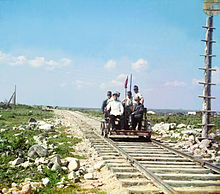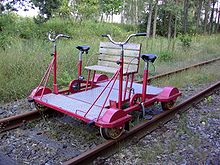- Handcar
-
 A handcar, in original condition (at the Shelburne Falls Trolley Museum). The foot brake operating mechanism may be seen between the wheels.
A handcar, in original condition (at the Shelburne Falls Trolley Museum). The foot brake operating mechanism may be seen between the wheels.
 A magic lantern image from circa 1895, shows four natives from British India pushing a hand-car in Bolan Pass (now in Pakistan).
A magic lantern image from circa 1895, shows four natives from British India pushing a hand-car in Bolan Pass (now in Pakistan).
A handcar (also known as a pump trolley, pump car, jigger, Kalamazoo,[1] or draisine (powered or unpowered) in many other parts of the world) is a railroad car powered by its passengers, or by people pushing the car from behind. It is mostly used as a maintenance of way or mining car, but it was also used for passenger service in some cases. A typical design consists of an arm that pivots, seesaw-like, on a base, which the passengers alternately push down and pull up to move the car.
Handcars have been normally used by railway service personnel for railroad inspection and maintenance. Because of their low weight and small size, they can be put on and taken off the rails at any place, allowing trains to pass. Handcars have since been replaced by self propelled vehicles that do not require the use of manual power, instead relying on internal combustion engines or electricity to move the vehicle.
Handcars are nowadays used by handcar enthusiasts at vintage railroad events and for races between handcars driven by five person teams (one to push the car from a halt, four to pump the lever). One such race has been held in Santa Rosa, California since 2008 and other races are held in Australia. See the section on racing below.
Contents
Australia
In Australia, hand cars or pump carts are commonly referred to as Kalamazoos after the Kalamazoo Manufacturing Company, which provided many examples to the Australian railway market.[1] Many Kalamazoos are preserved in Australia, some even being used for races.[2]
Bamboo cart
In Cambodia and other developing countries, local citizens sometimes make their own unofficial carts to transport goods along the railway tracks.
Japan
In Japan, dozens of commercially operated handcar railway lines, called human car tramway (人車軌道 jinsha kidō) or human car railway (人車鉄道 jinsha tetsudō) existed in early 20th century.[3] Those lines were purely built for its passenger/freight service, and "drivers" pushed small train cars all the way. The first line, Fujieda-Yaizu Tramway, opened in 1891, and most of the others opened before 1910. Most lines were very short with less than 10 km lengths, and the rail gauges used were either 2 ft 6 in (762 mm) or 2 ft (610 mm). As the human-powered system was fairly inefficient, many handcar tramways soon changed their power resources to either horse or gasoline. The system was not strong against a competition with other modes of transport, such as trucks, horses, buses, or other railways. Taishaku Handcar Tramway ceased its operation as early as 1912, and almost all the lines were already closed before 1945.
List of handcar tramways in Japan
- Hokkaidō
- Ebetsu Town Handcar Tramway 江別町営人車軌道
- Akita
- Nakanishi Tokugorō Operated Tramway 中西徳五郎経営軌道
- Yamagata
- Akayu Handcar Tramway 赤湯人車軌道
- Iwate
- Waga Light Tramway 和賀軽便軌道
- Miyagi
- Matsuyama Handcar Tramway 松山人車軌道
- Tochigi
- Ibaraki
- Haguro Tramway 羽黒軌道
- Inada Tramway 稲田軌道
- Iwama Tramway 岩間軌道
- Kabaho Kōgyō Tramway 樺穂興業軌道
- Kasama Handcar Tramway 笠間人車軌道
- Chiba
- Mobara-Chōnan Handcar Tramway 茂原・長南間人車軌道
- Noda Handcar Tramway 野田人車鉄道 (linemap)
- Ōhara-Ōtaki Handcar Tramway 大原・大多喜間人車軌道
- Tōkatsu Handcar Tramway 東葛人車鉄道
- Tokyo
- Taishaku Handcar Tramway 帝釈人車軌道
- The current Keisei Kanamachi Line.
- Taishaku Handcar Tramway 帝釈人車軌道
- Gunma
- Satomi Tramway 里見軌道
- Yabuzuka Stone Tramway 藪塚石材軌道
- The part of the current Tōbu Kiryū Line.
- Kanagawa
- Zusō Handcar Tramway 豆相人車鉄道
- Also in Shizuoka.
- Zusō Handcar Tramway 豆相人車鉄道
- Shizuoka
- Fujieda-Yaizu Tramway 藤枝焼津間軌道
- Nakaizumi Tramway 中泉軌道
- Shimada Tramway 島田軌道
- Fukui
- Hongō Tramway 本郷軌道
- Okinawa
- Okinawa Handcar Tramway 沖縄人車軌道
Taiwan
In Taiwan, commercially operated handcars were called either light railway line (Traditional Chinese: 輕便線; Hanyu Pinyin: qīngbiàn-xiàn), hand-pushed light railway line (手押輕便線; shǒuyā qīngbiàn-xiàn), hand-pushed tramway (手押軌道; shǒuyā guǐdào), or most commonly, hand-pushed wagon (手押臺車; shǒuyā táichē).[3] The first line was built in 1870s. The network developed later under Japanese rule. In 1933, its peak, there were more than 50 lines in the island with 1,292 km network, transporting local passengers, coals, factory products, sugars, salts, bananas, tea leaves, and others. Most lines, excluding those in mines and isolated islands, have disappeared after Japanese have left. However, a few lines survived well until 1970s. Currently, only the sightseeing line in Wūlái still exists, although its line is not human-powered anymore.
In popular culture
- Handcars are a recurring plot device of twentieth century film comedy. For example, the opening scene of Blazing Saddles, set at a railroad construction site, features a handcar.
- In the movie Mad Max Beyond Thunderdome, the culminating chase scene takes place along a railway, with one of the pursuers chasing the heroes down the tracks on a handcar.
- In the movie O Brother, Where Art Thou?, there is an old man who is always seen pushing one.
Handcar racing
Starting in 2008, an annual handcar race, known as the Hand-car Regatta, has been held in the railyard in downtown Santa Rosa, California. [4]
A multi-faceted festival, it is centred in races of numerous widely varying human-powered vehicles operating on railroad tracks. These include traditional hand-powered carts and others powered by pedals or pushing.
Other races are held in Australia, some using preserved old handcars. See the reference above discussing Kalamazoos in Australia.
See also
- Draisine
- Human-powered transport
- Railcar
- Some rowing cycles are inspired by early handcars
References
- ^ a b "Kalamazoo Railroad Velocipede and Car Company, Kalamazoo, Michigan, U.S.". http://motorcar.winkworth.us/kalamazoo/kalamazoo_co.htm. Retrieved 2008-03-22.
- ^ "Cummins Kalamazoo". Annual handcar race event at Cummins, South Australia. http://www.visitcummins.com/kalamazoo/kalamazoo.htm. Retrieved 2008-03-22.
- ^ a b These English names are just tentative translations for this article.
- ^ "Great West End Hand-Car Regatta". http://www.handcarregatta.com. Retrieved 2009-09-28.
External links
- PRR Hand Car diagrams
- History and other information
- The Hand-Car Regatta Race
- (Japanese) 全国人車鉄道一覧 (List of Handcar Tramways all Japan)
- (Japanese) 友蚋炭坑人車軌道 (Yǒuruì Coal Mine Handcar Tramway): About the handcar railway line in Taiwan.
Human-powered transport Land Pedal powerBicycle · Bicycle trailer · Cycle rickshaw · Freight bicycle · Mountain bike · Party Bike · Quadracycle · Recumbent bicycle · Road bike · Tandem bicycle · Trailer bike · Tricycle · Trikke · Unicycle · Velocar · Velocipede · VelomobileHand-powerRow-actionRowing cyclesFoot powerPushed/pulledBaby transport · Baggage cart · Gurney · Handcart · Hand truck · Pulled rickshaw · Shopping cart · Stairclimber · WheelbarrowCarriedWater Snow and ice Alpine touring skis · Crampons · Cross-country skis · Ice skates · Kicksled · Snowshoes · Telemark skis · Snowboard · SledAir Categories:- Maintenance of way equipment
- Human-powered vehicles
- Hokkaidō
Wikimedia Foundation. 2010.







